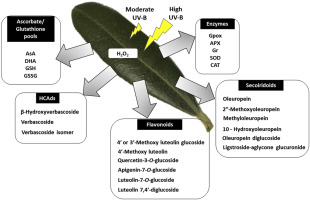当前位置:
X-MOL 学术
›
Phytochemistry
›
论文详情
Our official English website, www.x-mol.net, welcomes your
feedback! (Note: you will need to create a separate account there.)
The antioxidant system in Olea europaea to enhanced UV-B radiation also depends on flavonoids and secoiridoids
Phytochemistry ( IF 3.2 ) Pub Date : 2020-02-01 , DOI: 10.1016/j.phytochem.2019.112199 Maria Celeste Dias 1 , Diana C G A Pinto 2 , Helena Freitas 3 , Conceição Santos 4 , Artur M S Silva 2
Phytochemistry ( IF 3.2 ) Pub Date : 2020-02-01 , DOI: 10.1016/j.phytochem.2019.112199 Maria Celeste Dias 1 , Diana C G A Pinto 2 , Helena Freitas 3 , Conceição Santos 4 , Artur M S Silva 2
Affiliation

|
The Mediterranean crop Olea europaea is often exposed to high UV-B irradiation conditions. To understand how this species modulates its enzymatic and non-enzymatic antioxidant system under high UV-B radiation, young O. europaea plants (cultivar "Galega Vulgar") were exposed, for five days, to UV-B radiation (6.5 kJ m-2 d-1 and 12.4 kJ m-2 d-1). Our data indicate that UV-doses slightly differ in the modulation of the antioxidant protective mechanisms. Particularly, superoxide dismutase (SOD), guaiacol peroxidase (GPox) and catalase (CAT) activities increased contributing to H2O2 homeostasis, being more solicited by higher UV-B doses. Also, glutathione reductase (Gr) activity, ascorbate (AsA) and reduced glutathione (GSH) pools increased particularly under the highest dose, suggesting a higher mobilization of the antioxidant system in this dose. The leaf metabolites' profile of this cultivar was analysed by UHPLC-MS. Interestingly, high levels of verbascoside were found, followed by oleuropein and luteolin-7-O-glucoside. Both UV-B treatments affected mostly less abundant flavonoids (decreasing 4'-methoxy luteolin and 4' or 3'-methoxy luteolin glucoside) and hydroxycinnamic acid derivatives (HCAds, increasing β-hydroxyverbascoside). These changes show not only different mobilization with the UV-intensity, but also reinforce for the first time the protective roles of these minor compounds against UV-B, as reactive oxygen species (ROS) scavengers and UV-B shields, in complement with other antioxidant systems (e.g. AsA/GSH cycle), particularly for high UV-B doses. Secoiridoids also standout in the response to both UV-B doses, with decreases of oleuropein and increases 2''-methoxyoleuropein. Being oleuropein an abundant compound, data suggest that secoiridoids play a more important role than flavonoids and HCAds, in O. europaea protection against UV-B, possibly by acting as signalling molecules and ROS scavengers. This is the first report on the influence of UV-B radiation on the secoiridoid oleuropein, and provides a novel insight to the role of this compound in the O. europaea antioxidant defence mechanisms.
中文翻译:

Olea europaea 中增强 UV-B 辐射的抗氧化系统也依赖于类黄酮和类环烯醚萜
地中海作物 Olea europaea 经常暴露在高 UV-B 辐射条件下。为了了解该物种如何在高 UV-B 辐射下调节其酶促和非酶促抗氧化系统,将年轻的 O. europaea 植物(栽培品种“Galega Vulgar”)暴露于 UV-B 辐射(6.5 kJ m- 2 d-1 和 12.4 kJ m-2 d-1)。我们的数据表明,紫外线剂量在抗氧化保护机制的调节方面略有不同。特别是,超氧化物歧化酶 (SOD)、愈创木酚过氧化物酶 (GPox) 和过氧化氢酶 (CAT) 活性增加,有助于 H2O2 稳态,更高的 UV-B 剂量更需要。此外,谷胱甘肽还原酶 (Gr) 活性、抗坏血酸 (AsA) 和还原型谷胱甘肽 (GSH) 池尤其在最高剂量下增加,表明在这个剂量下抗氧化系统有更高的动员。通过 UHPLC-MS 分析了该品种的叶代谢物谱。有趣的是,发现了高水平的毛蕊花苷,其次是橄榄苦苷和木犀草素-7-O-葡萄糖苷。两种 UV-B 处理主要影响较少丰富的黄酮类化合物(减少 4'-甲氧基木犀草素和 4' 或 3'-甲氧基木犀草素葡萄糖苷)和羟基肉桂酸衍生物(HCAds,增加 β-羟基木犀草苷)。这些变化不仅显示出不同的紫外线强度动员,而且首次加强了这些微量化合物对 UV-B 的保护作用,作为活性氧 (ROS) 清除剂和 UV-B 屏蔽物,与其他化合物相辅相成。抗氧化系统(例如 AsA/GSH 循环),特别是对于高 UV-B 剂量。Secoiridoids 在对两种 UV-B 剂量的反应中也很突出,橄榄苦苷减少,2''-甲氧基橄榄苦苷增加。橄榄苦苷是一种丰富的化合物,数据表明,在 O. europaea 对 UV-B 的保护中,secoiridoids 比黄酮类化合物和 HCDs 发挥更重要的作用,可能是通过充当信号分子和 ROS 清除剂。这是关于 UV-B 辐射对 secoiridoid oleuropein 影响的第一份报告,并为该化合物在 O. europaea 抗氧化防御机制中的作用提供了新的见解。可能通过充当信号分子和 ROS 清除剂。这是关于 UV-B 辐射对 secoiridoid oleuropein 影响的第一份报告,并为该化合物在 O. europaea 抗氧化防御机制中的作用提供了新的见解。可能通过充当信号分子和 ROS 清除剂。这是关于 UV-B 辐射对 secoiridoid oleuropein 影响的第一份报告,并为该化合物在 O. europaea 抗氧化防御机制中的作用提供了新的见解。
更新日期:2020-02-01
中文翻译:

Olea europaea 中增强 UV-B 辐射的抗氧化系统也依赖于类黄酮和类环烯醚萜
地中海作物 Olea europaea 经常暴露在高 UV-B 辐射条件下。为了了解该物种如何在高 UV-B 辐射下调节其酶促和非酶促抗氧化系统,将年轻的 O. europaea 植物(栽培品种“Galega Vulgar”)暴露于 UV-B 辐射(6.5 kJ m- 2 d-1 和 12.4 kJ m-2 d-1)。我们的数据表明,紫外线剂量在抗氧化保护机制的调节方面略有不同。特别是,超氧化物歧化酶 (SOD)、愈创木酚过氧化物酶 (GPox) 和过氧化氢酶 (CAT) 活性增加,有助于 H2O2 稳态,更高的 UV-B 剂量更需要。此外,谷胱甘肽还原酶 (Gr) 活性、抗坏血酸 (AsA) 和还原型谷胱甘肽 (GSH) 池尤其在最高剂量下增加,表明在这个剂量下抗氧化系统有更高的动员。通过 UHPLC-MS 分析了该品种的叶代谢物谱。有趣的是,发现了高水平的毛蕊花苷,其次是橄榄苦苷和木犀草素-7-O-葡萄糖苷。两种 UV-B 处理主要影响较少丰富的黄酮类化合物(减少 4'-甲氧基木犀草素和 4' 或 3'-甲氧基木犀草素葡萄糖苷)和羟基肉桂酸衍生物(HCAds,增加 β-羟基木犀草苷)。这些变化不仅显示出不同的紫外线强度动员,而且首次加强了这些微量化合物对 UV-B 的保护作用,作为活性氧 (ROS) 清除剂和 UV-B 屏蔽物,与其他化合物相辅相成。抗氧化系统(例如 AsA/GSH 循环),特别是对于高 UV-B 剂量。Secoiridoids 在对两种 UV-B 剂量的反应中也很突出,橄榄苦苷减少,2''-甲氧基橄榄苦苷增加。橄榄苦苷是一种丰富的化合物,数据表明,在 O. europaea 对 UV-B 的保护中,secoiridoids 比黄酮类化合物和 HCDs 发挥更重要的作用,可能是通过充当信号分子和 ROS 清除剂。这是关于 UV-B 辐射对 secoiridoid oleuropein 影响的第一份报告,并为该化合物在 O. europaea 抗氧化防御机制中的作用提供了新的见解。可能通过充当信号分子和 ROS 清除剂。这是关于 UV-B 辐射对 secoiridoid oleuropein 影响的第一份报告,并为该化合物在 O. europaea 抗氧化防御机制中的作用提供了新的见解。可能通过充当信号分子和 ROS 清除剂。这是关于 UV-B 辐射对 secoiridoid oleuropein 影响的第一份报告,并为该化合物在 O. europaea 抗氧化防御机制中的作用提供了新的见解。











































 京公网安备 11010802027423号
京公网安备 11010802027423号